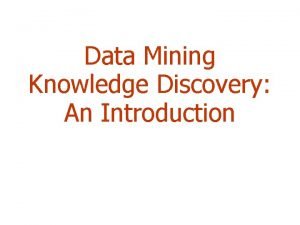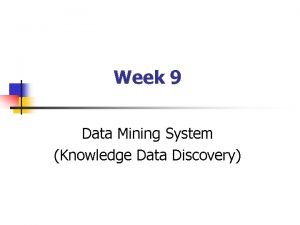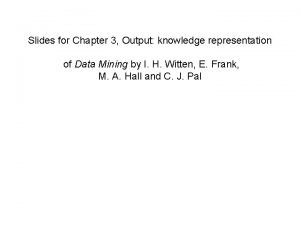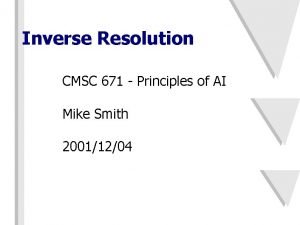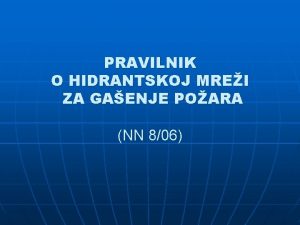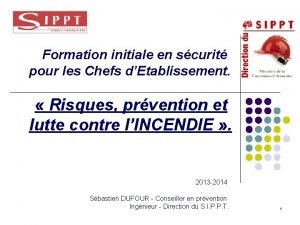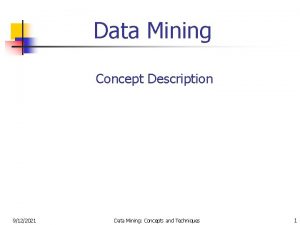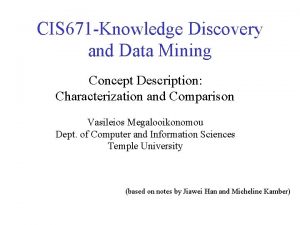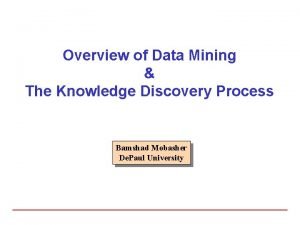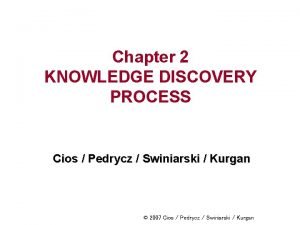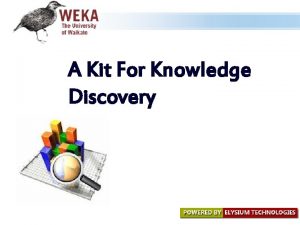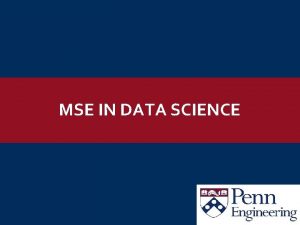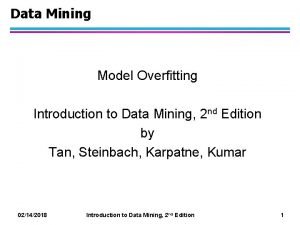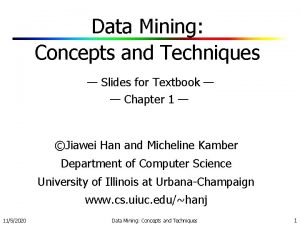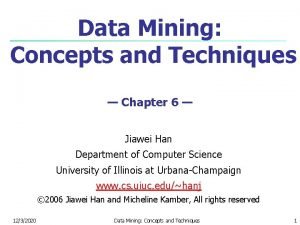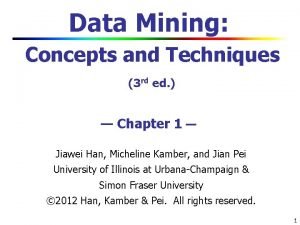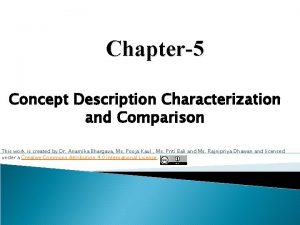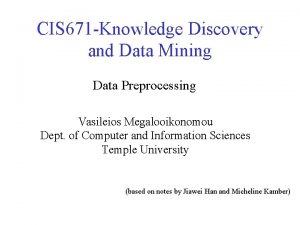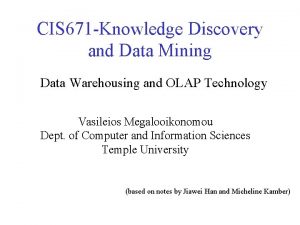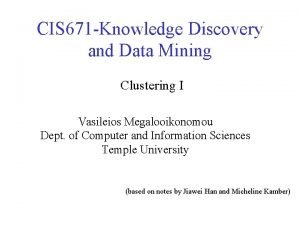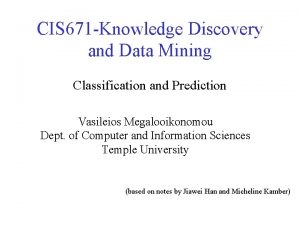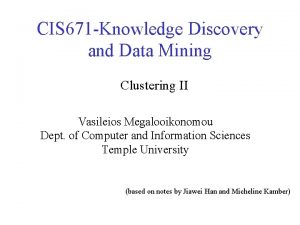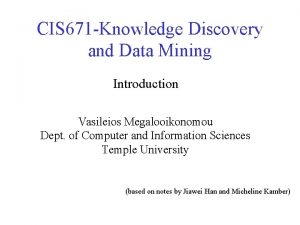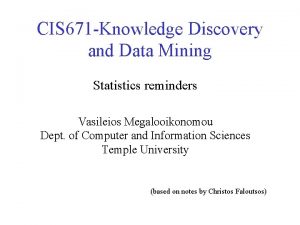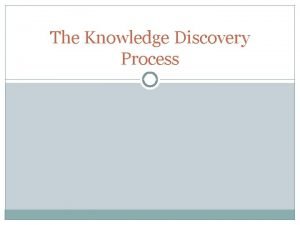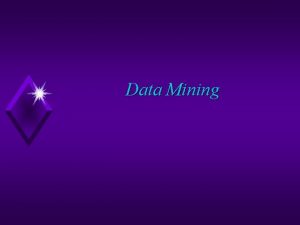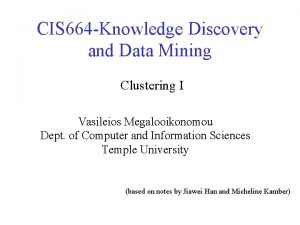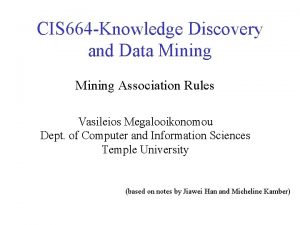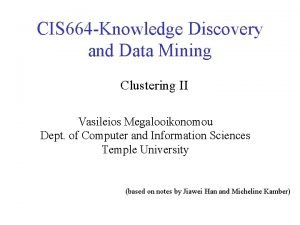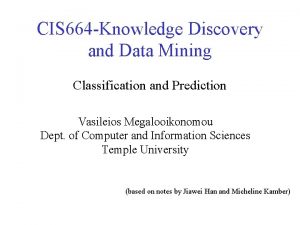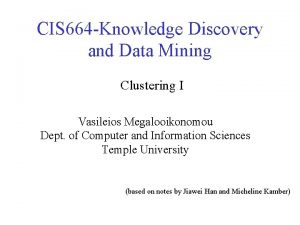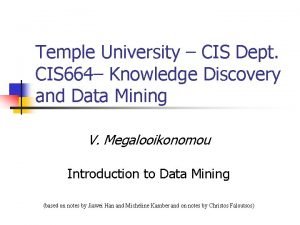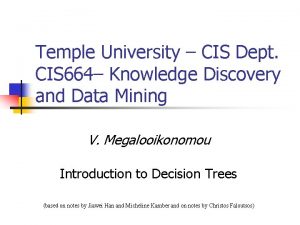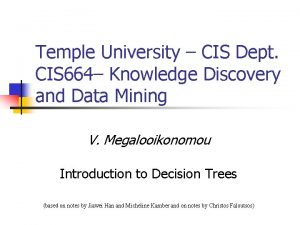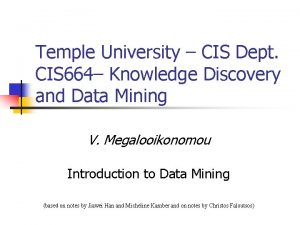CIS 671 Knowledge Discovery and Data Mining Concept

















































- Slides: 49

CIS 671 -Knowledge Discovery and Data Mining Concept Description: Characterization and Comparison Vasileios Megalooikonomou Dept. of Computer and Information Sciences Temple University (based on notes by Jiawei Han and Micheline Kamber)

Agenda • What is concept description? • Data generalization and summarization-based characterization • Analytical characterization: Analysis of attribute relevance • Mining class comparisons: Discriminating between different classes • Mining descriptive statistical measures in large databases • Discussion • Summary

What is Concept Description? • Descriptive vs. predictive data mining – Descriptive mining: describes concepts or task-relevant data sets in concise, summarative, informative, discriminative forms – Predictive mining: constructs models for the database, and predicts the trend and properties of unknown data • Concept description: – Characterization: provides a concise summarization of the data – Comparison: provides descriptions comparing two or more collections of data

Concept Description vs. OLAP • Concept description: – can handle complex data types of the attributes and their aggregations – automated process • OLAP: – restricted to a small number of dimension and measure types – user-controlled process

Agenda • What is concept description? • Data generalization and summarization-based characterization • Analytical characterization: Analysis of attribute relevance • Mining class comparisons: Discriminating between different classes • Mining descriptive statistical measures in large databases • Discussion • Summary

Summarization-based Characterization • Data generalization – A process which abstracts a large set of task-relevant data in a database from a low conceptual levels to higher ones. – Approaches: • Data cube approach (OLAP approach) – Limitations » handle only dimensions of simple nonnumeric data and measures of simple aggregated numeric values. » Lack of intelligent analysis (can’t tell which dimensions should be used and what levels should the generalization reach) • Attribute-oriented induction (AOI) approach

Attribute-Oriented Induction • Proposed in 1989 (KDD ‘ 89 workshop) • Not confined to categorical data nor particular measures. • How it is done? – Collect the task-relevant data ( initial relation) using a relational database query – Perform generalization by attribute removal or attribute generalization. – Apply aggregation by merging identical, generalized tuples and accumulating their respective counts. – Interactive presentation with users.

Basic Principles of Attribute-Oriented Induction • Data focusing: task-relevant data, including dimensions, and the result is the initial relation. • Attribute-removal: remove attribute A if there is a large set of distinct values for A but (1) there is no generalization operator on A, or (2) A’s higher level concepts are expressed in terms of other attributes. • Attribute-generalization: If there is a large set of distinct values for A, and there exists a set of generalization operators on A, then select an operator and generalize A. • Attribute-threshold control: typical 2 -8, specified/default. • Generalized relation threshold control: control the final relation/rule size. • Presentation: User interaction: (1) adjust levels by drilling, (2) pivoting, (3) mapping into rules, cross tabs, visualization.

Class Characterization: An Example Describe general characteristics of graduate students in the University database Initial Relation Prime Generalized Relation Crosstab See Principles See Algorithm See Implementation See Analytical Characterization

Presentation of Generalized Results • Generalized relation: – Relations where some or all attributes are generalized, with counts or other aggregation values accumulated. • Cross tabulation: – Mapping results into cross tabulation form (similar to contingency tables). – Visualization techniques: – Pie charts, bar charts, curves, cubes, and other visual forms. • Quantitative characteristic rules: – Mapping generalized result into characteristic rules with quantitative information associated with it, e. g. ,

Agenda • What is concept description? • Data generalization and summarization-based characterization • Analytical characterization: Analysis of attribute relevance • Mining class comparisons: Discriminating between different classes • Mining descriptive statistical measures in large databases • Discussion • Summary

Attribute Relevance Analysis • Why? – – Which dimensions should be included? How high level of generalization? Automatic vs. interactive Reduce # attributes; easy to understand patterns • What? – statistical method for preprocessing data • filter out irrelevant or weakly relevant attributes • retain or rank the relevant attributes – relevance related to dimensions and levels – analytical characterization, analytical comparison

Attribute relevance analysis (cont’d) • How? – Data Collection – Analytical Generalization • Use information gain analysis (e. g. , entropy or other measures) to identify highly relevant dimensions and levels. – Relevance Analysis • Sort and select the most relevant dimensions and levels. – Attribute-oriented Induction for class description • On selected dimension/level – OLAP operations (e. g. drilling, slicing) on relevance rules

Relevance Measures • To determine the classifying power of an attribute within a set of data. • Methods – information gain (ID 3) – gain ratio (C 5. 0) – gini index – 2 contingency table statistics – uncertainty coefficient

Information-Theoretic Approach • Decision tree – each internal node tests an attribute – each branch corresponds to attribute value – each leaf node assigns a classification • ID 3 algorithm – build decision tree based on training objects with known class labels to classify testing objects – rank attributes with information gain measure – minimal height • the least number of tests to classify an object See example

Top-Down Induction of Decision Tree Attributes = {Outlook, Temperature, Humidity, Wind} Play. Tennis = {yes, no} Outlook sunny overcast Humidity high no rain Wind yes normal yes strong no weak yes

Entropy and Information Gain • S contains si tuples of class Ci for i = {1, …, m} • Information measures info required to classify any arbitrary tuple • Entropy of attribute A with values {a 1, a 2, …, av} • Information gained by branching on attribute A

Example: Analytical Characterization • Task – Mine general characteristics describing graduate students using analytical characterization • Given – attributes name, gender, major, birth_place, birth_date, phone#, and gpa – Gen(ai) = concept hierarchies on ai – Ui = attribute analytical thresholds for ai – Ti = attribute generalization thresholds for ai – R = attribute relevance threshold

Example: Analytical Characterization (cont’d) • 1. Data collection – target class: graduate student – contrasting class: undergraduate student • 2. Analytical generalization using Ui – attribute removal • remove name and phone# – attribute generalization • generalize major, birth_place, birth_date and gpa • accumulate counts – candidate relation: gender, major, birth_country, age_range and gpa

Example: Analytical characterization (2) Candidate relation for Target class: Graduate students ( =120) Candidate relation for Contrasting class: Undergraduate students ( =130)

Example: Analytical characterization (3) • 3. Relevance analysis – Calculate expected info required to classify an arbitrary tuple – Calculate entropy of each attribute: e. g. major Number of grad students in “Science” Number of undergrad students in “Science”

Example: Analytical Characterization (4) • Calculate expected info required to classify a given sample if S is partitioned according to the attribute • Calculate information gain for each attribute – Information gain for all attributes

Example: Analytical characterization (5) • 4. Initial working relation (W 0) derivation – R = 0. 1 – remove irrelevant/weakly relevant attributes from candidate relation => drop gender, birth_country – remove contrasting class candidate relation Initial target class working relation W 0: Graduate students • 5. Perform attribute-oriented induction on W 0 using Ti

Agenda • What is concept description? • Data generalization and summarization-based characterization • Analytical characterization: Analysis of attribute relevance • Mining class comparisons: Discriminating between different classes • Mining descriptive statistical measures in large databases • Discussion • Summary

Mining Class Comparisons • • Comparison: Comparing two or more classes. Method: – – – Partition the set of relevant data into the target class and the contrasting class(es) Generalize both classes to the same high level concepts Compare tuples with the same high level descriptions Present for every tuple its description and two measures: • support - distribution within single class • comparison - distribution between classes Highlight the tuples with strong discriminant features Relevance Analysis: • Find attributes (features) which best distinguish different classes.

Example: Analytical comparison • Task – Compare graduate and undergraduate students using discriminant rule. • Given –attributes name, gender, major, birth_place, birth_date, residence, phone# and gpa –Gen(ai) = concept hierarchies on attributes ai –Ui = attribute analytical thresholds for attributes ai –Ti = attribute generalization thresholds for attributes ai –R = attribute relevance threshold

Example: Analytical comparison (2) • 1. Data collection – target and contrasting classes • 2. Attribute relevance analysis – remove attributes name, gender, major, phone# • 3. Synchronous generalization – controlled by user-specified dimension thresholds – prime target and contrasting class(es) relations

Example: Analytical comparison (3) Prime generalized relation for the target class: Graduate students Prime generalized relation for the contrasting class: Undergraduate students

Example: Analytical comparison (4) • 4. Drill down, roll up and other OLAP operations on target and contrasting classes to adjust levels of abstractions of resulting description • 5. Presentation – as generalized relations, crosstabs, bar charts, or rules – contrasting measures to reflect comparison between target and contrasting classes • e. g. count%

Quantitative Discriminant Rules • Cj = target class • qa = a generalized tuple covers some tuples of class – but can also cover some tuples of contrasting class • d-weight – range: [0, 1] • quantitative discriminant rule form

Example: Quantitative Discriminant Rule Count distribution between graduate and undergraduate students for a generalized tuple • Quantitative discriminant rule – where 90/(90+120) = 30%

Class Description • Quantitative characteristic rule – necessary • Quantitative discriminant rule – sufficient • Quantitative description rule – necessary and sufficient

Example: Quantitative Description Rule Crosstab showing associated t-weight, d-weight values and total number (in thousands) of TVs and computers sold at All. Electronics in 1998 • Quantitative description rule for target class Europe

Agenda • What is concept description? • Data generalization and summarization-based characterization • Analytical characterization: Analysis of attribute relevance • Mining class comparisons: Discriminating between different classes • Mining descriptive statistical measures in large databases • Discussion • Summary

Mining Data Dispersion Characteristics • Motivation – • Data dispersion characteristics – • • To better understand the data: central tendency, variation and spread median, max, min, quantiles, outliers, variance, etc. Numerical dimensions correspond to sorted intervals – Data dispersion: analyzed with multiple granularities of precision – Boxplot or quantile analysis on sorted intervals Dispersion analysis on computed measures – Folding measures into numerical dimensions – Boxplot or quantile analysis on the transformed cube

Measuring the Central Tendency • Mean – • Weighted arithmetic mean Median: A holistic measure – Middle value if odd number of values, or average of the middle two values otherwise – • estimated by interpolation Mode – Value that occurs most frequently in the data – Unimodal, bimodal, trimodal – Empirical formula:

Measuring the Dispersion of Data • • Quartiles, outliers and boxplots – Quartiles: Q 1 (25 th percentile), Q 3 (75 th percentile) – Inter-quartile range: IQR = Q 3 – Q 1 – Five number summary: min, Q 1, M, Q 3, max – Boxplot: ends of the box are the quartiles, median is marked, whiskers, and plot outlier individually – Outlier: usually, a value higher/lower than 1. 5 x IQR Variance and standard deviation – Variance s 2: (algebraic, scalable computation) – Standard deviation s is the square root of variance s 2

Boxplot Analysis • Five-number summary of a distribution: Minimum, Q 1, M, Q 3, Maximum • Boxplot – Data is represented with a box – The ends of the box are at the first and third quartiles, i. e. , the height of the box is IRQ – The median is marked by a line within the box – Whiskers: two lines outside the box extend to Minimum and Maximum

Visualization of Data Dispersion: Boxplot Analysis

Mining Descriptive Statistical Measures in Large Databases • Variance • Standard deviation: the square root of the variance – Measures spread about the mean – It is zero if and only if all the values are equal – Both the deviation and the variance are algebraic

Histogram Analysis • Graph displays of basic statistical class descriptions – Frequency histograms • A univariate graphical method • Consists of a set of rectangles that reflect the counts or frequencies of the classes present in the given data

Quantile Plot • Displays all of the data (allowing the user to assess both the overall behavior and unusual occurrences) • Plots quantile information – For a data xi data sorted in increasing order, fi indicates that approximately 100 fi% of the data are below or equal to the value xi

Quantile-Quantile (Q-Q) Plot • Graphs the quantiles of one univariate distribution against the corresponding quantiles of another • Allows the user to view whethere is a shift in going from one distribution to another

Scatter plot • Provides a first look at bivariate data to see clusters of points, outliers, etc • Each pair of values is treated as a pair of coordinates and plotted as points in the plane

Loess (Local Regression) Curve • Adds a smooth curve to a scatter plot in order to provide better perception of the pattern of dependence • Loess curve is fitted by setting two parameters: a smoothing parameter, and the degree of the polynomials that are fitted by the regression

Agenda • What is concept description? • Data generalization and summarization-based characterization • Analytical characterization: Analysis of attribute relevance • Mining class comparisons: Discriminating between different classes • Mining descriptive statistical measures in large databases • Discussion • Summary

AO Induction vs. Learning-fromexample • Difference in philosophies and basic assumptions – Positive and negative samples in learning-from-example: positive used for generalization, negative - for specialization – Positive samples only in data mining: hence generalizationbased, to drill-down backtrack the generalization to a previous state • Difference in methods of generalizations – Machine learning generalizes on a tuple by tuple basis – Data mining generalizes on an attribute by attribute basis

Incremental and Parallel Mining of Concept Description • Incremental mining: revision based on newly added data DB – Generalize DB to the same level of abstraction in the generalized relation R to derive R – Union, R U R, i. e. , merge counts and other statistical information to produce a new relation R’ • Similar philosophy can be applied to data sampling, parallel and/or distributed mining, etc.

Summary • Concept description: characterization and discrimination • OLAP-based vs. attribute-oriented induction • Analytical characterization and comparison • Mining descriptive statistical measures in large databases • Discussion – Incremental and parallel mining of description – Descriptive mining of complex types of data
 Introduction to data mining and knowledge discovery
Introduction to data mining and knowledge discovery Eck
Eck Mining multimedia databases in data mining
Mining multimedia databases in data mining Knowledge data discovery
Knowledge data discovery Knowledge representation in data mining
Knowledge representation in data mining Ai 671
Ai 671 How to get voicemail on airtel
How to get voicemail on airtel Find the odd one : 396, 462, 572, 427, 671, 264
Find the odd one : 396, 462, 572, 427, 671, 264 Dužina cijevi u zidnom hidrantu
Dužina cijevi u zidnom hidrantu Nbn s21 204
Nbn s21 204 Difference between strip mining and open pit mining
Difference between strip mining and open pit mining Text and web mining
Text and web mining Concept description in data mining
Concept description in data mining Relevance analysis in data mining
Relevance analysis in data mining What is data mining and data warehousing
What is data mining and data warehousing Mining fraud
Mining fraud Olap database
Olap database Introduction to data warehousing and data mining
Introduction to data warehousing and data mining Strip mining vs open pit mining
Strip mining vs open pit mining Strip mining before and after
Strip mining before and after Knowledge discovery process
Knowledge discovery process Systematic inquiry aimed at the discovery of new knowledge
Systematic inquiry aimed at the discovery of new knowledge Knowledge discovery process
Knowledge discovery process Systematic inquiry aimed at the discovery of new knowledge
Systematic inquiry aimed at the discovery of new knowledge Kdd task manager
Kdd task manager Knowledge discovery kit
Knowledge discovery kit Data reduction in data mining
Data reduction in data mining What is missing data in data mining
What is missing data in data mining Concept hierarchy generation for nominal data
Concept hierarchy generation for nominal data Data reduction in data mining
Data reduction in data mining Data reduction in data mining
Data reduction in data mining Data cube technology in data mining
Data cube technology in data mining Data reduction in data mining
Data reduction in data mining Data warehouse dan data mining
Data warehouse dan data mining Data mining dan data warehouse
Data mining dan data warehouse Complex data types in data mining
Complex data types in data mining Noisy data in data mining
Noisy data in data mining Three tier data warehouse
Three tier data warehouse Data preparation for data mining
Data preparation for data mining Data compression in data mining
Data compression in data mining Data warehouse dan data mining
Data warehouse dan data mining Complex data types in data mining
Complex data types in data mining Knowledge creation and knowledge architecture
Knowledge creation and knowledge architecture Mse data science upenn
Mse data science upenn Underfitting and overfitting in data mining
Underfitting and overfitting in data mining Data mining concepts and techniques slides
Data mining concepts and techniques slides Underfitting and overfitting in data mining
Underfitting and overfitting in data mining Data mining concepts and techniques
Data mining concepts and techniques Characterization and comparison in data mining
Characterization and comparison in data mining Data mining primitives languages and system architecture
Data mining primitives languages and system architecture
